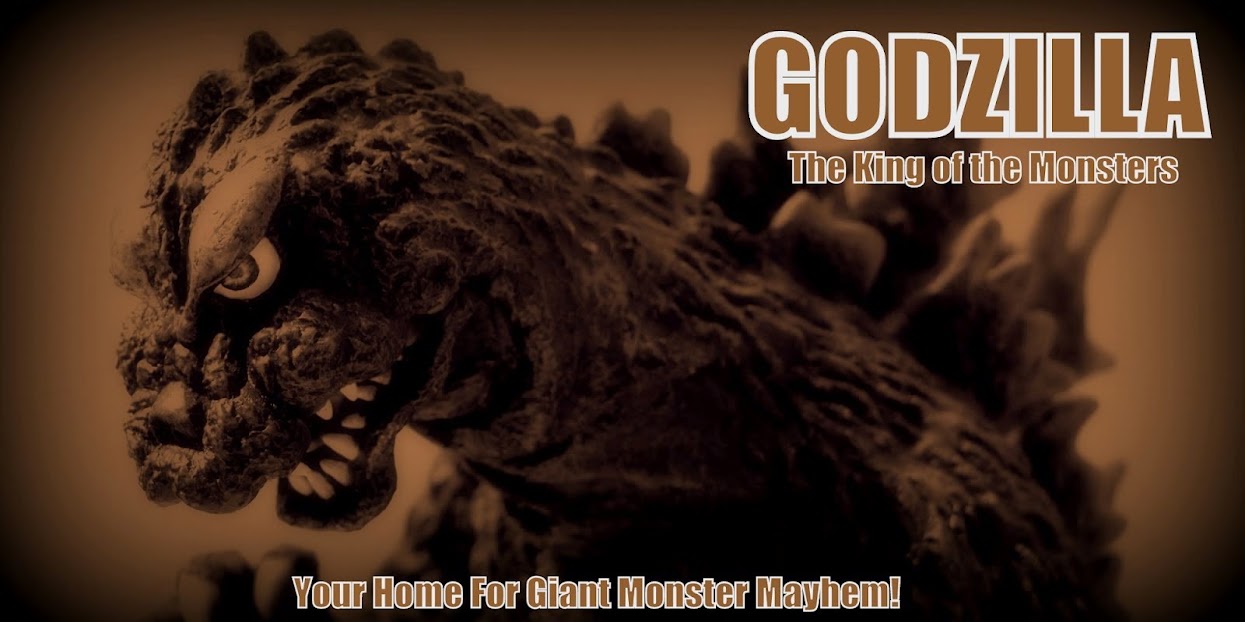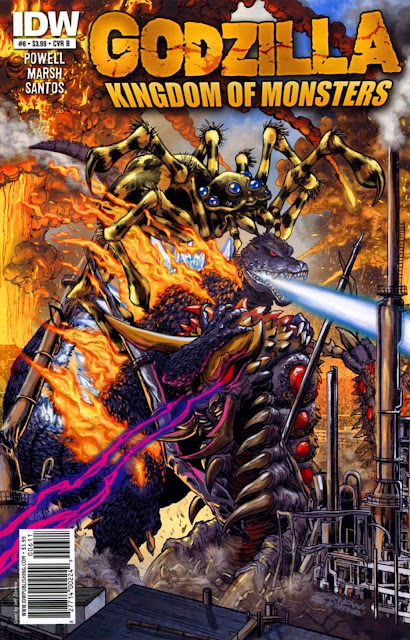From Warner Bros
Like the title character, the story told in the film begins in Japan. “That’s the birthplace of Godzilla, so we thought it would be an appropriate place to begin our story, which takes us half-way around the world, ultimately reaching San Francisco, where the big battle plays out,” Tull says.
The film was shot on location on the Hawaiian island of Oahu; Las Vegas, Nevada; and Vancouver, B.C., in Canada, with additional shooting in San Diego, California, and Tokyo, Japan. Paterson and his art department—led by supervising art director Grant Van Der Slagt, along with art directors Dan Hermansen, Ross Dempster and Kristen Franson, and set decorator Elizabeth Wilcox—designed and created complex, detailed interior and exterior sets on soundstages and backlot space at the Canadian Motion Picture Park (CMPP), in the Vancouver suburb of Burnaby.
One of the first sequences to be shot was at the Vancouver Convention Center, with the cavernous structure transformed into both the Honolulu and Tokyo International Airports.
A number of key Canadian locales became ground zero for some of the film’s most dramatic scenes of devastation. “A giant creature is never going to come and smash up our cities, but probably every human being on this planet has either lived through events that create that kind of destruction or seen their effects on TV,” Edwards notes.
The streets of downtown Vancouver were transformed into San Francisco’s besieged financial district for a number of evocative sequences. Elizabeth Olsen was present for one such scene, which placed her among a flood of refugees fleeing in terror from the monster-sized clash tearing up their city. “One of the coolest experiences for me was being a part of these scenes of people trying to find their way to safety,” Olsen remembers. “I was part of this massive group of people all going in the same direction. I had never been involved in a scene with so many extras before, but there’s something about being a part of a body of people that hits you at a primal level. It felt very real in the context of what’s going on in the scene.”
San Francisco was also pieced together on the backlot at CMPP. On one backlot set, Paterson redesigned an existing cityscape set to portray a small Chinatown street, and also built the entrance to a giant sinkhole beneath Chinatown, which is Ford’s target when he plunges with a HALO [High Altitude - Low Opening] team into the city.
The chaotic sinkhole set itself, which Edwards called the “Dragon’s Den,” was built inside a soundstage, and dressed to overflow with crashed cars, chunks of buildings and other debris. After shooting was completed on this sequence, the set was repurposed to portray the massive cavern beneath the collapsed Philippine mine where scientists Graham and Serizawa gain their first insight that something massive and unknown has been released into the world. “We discover that this cave isn’t really a natural cave—it’s a giant ribcage, with bones that loom 25 feet in the air,” Paterson describes. “It’s a good place to start the story, in a sense. The genie has been let out of the bottle.”
“That set was beyond amazing, just extraordinary,” raves Sally Hawkins. “Even though we were working with some green screen, a lot of the time we didn’t have to imagine anything. It was there. We were inside this giant structure, and the detail was phenomenal. It made it very easy for the cast to have these incredible worlds for you to step onto.”
Edwards observes that shooting both sequences within the same soundstage reflects some of the symmetry woven into the film’s DNA. “What Graham and Serizawa observe within the giant ribcage at the beginning of the film, and what Ford sees in the Dragon’s Den near the end are linked in the story,” he says. “So in a way, it felt like going full circle.”
Another exterior set Paterson built on the CMPP backlot was a 400-foot stretch of the 8,980-foot-long Golden Gate Bridge, where Edwards, aided by veteran second unit director E.J. Foerster, staged some of the film’s exciting climactic moments, with the city’s famous skyline looming in the background.
To achieve this effect, Rygiel dispatched teams to the tops of some of San Francisco’s skyscrapers to shoot high-end panoramas from multiple angles that took in the entire 360 degrees of the skyline, which, using photogrammetry, they were able to merge into a 3D city. “This technique gives you a real city that is accurate down to every piece of mortar in a brick building,” he says. “So, using that, we were able to composite the live action shots with the keyframe-animated monsters destroying digital buildings into a seamless whole.”
Another key site for the production was Finn Slough, a century-old unincorporated Finnish fishing settlement along the Fraser River in Richmond, B.C. Now nearly abandoned, Finn Slough’s few residents live in crumbling wooden shacks, both floating and built on stilts, along the marshy river bank. Edwards used the unique site, as well as pockets of New Westminster dressed to appear reclaimed by nature, to portray the Tokyo quarantine zone Ford ventures into with his father to locate his childhood home.
Two other significant Vancouver locations were chosen to portray the Janjira Nuclear Power Plant: the abandoned and decayed Catalyst paper mill for the exteriors; and the Annacis Island wastewater treatment facility south of Vancouver for its interiors, augmented by an evocative soundstage set of the nuclear chambers.
Other Vancouver locations included the banks of Lake Alouette in Golden Ears Provincial Park, where Edwards staged a helicopter rescue amidst a landscape of destruction; and the boat docks of Steveston, Vancouver, which became San Francisco’s famed Fisherman’s Wharf.
Once the Canadian portion of production concluded, the company shipped off to the most populous of the Hawaiian Islands, Oahu, to shoot a variety of locations, from Waikiki Beach to a rock quarry that provided the entrance to the collapsed mine.
To capture shots for the film's main title sequence, production traveled to the Windward (or East) side of Oahu to recreate a Pacific Atoll where hydrogen bomb tests were conducted in the early 1950s and, in fact, resulted in a tragic loss of life the same year the original “Godzilla” was released.
The company next touched down on a part of existing World War II history at Pearl Harbor, which serves as both a working naval base and a somber memorial for those lost in the event that precipitated America’s entry into war. Here, Edwards staged three scenes onboard the USS Missouri, with the historic “floating memorial” standing in for the massive USS Saratoga battleship that tracks Godzilla across the Pacific. Moving to the adjacent Hickam Air Force Base, Edwards shot Aaron Taylor-Johnson within an actual C-17 aircraft to depict the moments just prior to his HALO plunge into San Francisco.
James D. Dever, the film’s military technical advisor, had participated in HALO jumps, and worked with HALO Jump stunt coordinator JT Holmes to bring the highest degree of authenticity to the dramatic free fall. “The stunt performers were HALO-trained and did an outstanding job,” Dever says. “In this movie, you’ll see the Air Force moving ICBM missiles, the Navy running an aircraft carrier, and a lot of moving parts from Huey helicopters, destroyers and flying F-35s. My job was to make sure it was all accurately represented.”
In addition to consulting on military arcana, such as chain of command, terminology, gear, weapons, and environments, Dever also liaised with the Department of Defense to help secure the film’s array of military assets, as well as a full complement of U.S. and Canadian servicemen to portray the majority of forces seen in the film. “It turns out that a lot of people in the Department of Defense are massive Godzilla fans too,” Edwards smiles, “and I think they got a kick out of participating in this movie.”
A retired Sergeant Major in the U.S. Marine Corps, Dever also worked with Aaron Taylor-Johnson to ensure his Navy bearing was up to snuff. “I had three days of working in boot camp with him, teaching him how to use his weapon, how to put his gear on, how to move and present himself as an officer in the U.S. Navy,” Dever says. “And Aaron was like a sponge for information because he wanted to get it right, and he did. It was a pleasure working with him.”
The production also took over a stretch of the popular Waikiki Beachfront for two days to complete sequences tied to the arrival of a tsunami that destroys one of the beach’s most recognizable landmarks, the Hilton Rainbow Tower. The production accomplished the near-impossible by closing Waikiki’s most popular commercial shopping strip, Lewers Street, for fifteen hours to capture footage of hundreds of extras fleeing the giant wave.
“Our intentions with this environment and all the scenes of devastation in the film was absolute reality,” says Paterson. “Gareth wanted the sets to feel so real that people would walk out of the cinema after seeing the movie and actually not expect to see buildings still standing.”
“It’s that much more thrilling, intense and ultimately, I think, a more satisfying movie experience if you believe it,” adds Parent. “Godzilla deserves to have his story told within a movie that’s worthy, and Gareth was able to put together a group of people at the top of their game with the skills and artistry to do it in a way that has never been seen before. It’s a good match, and gives you a front row seat for an epic adventure, with the iconic Godzilla at the center of it.”
Says Rogers, “I am so proud to be a part of the talented team responsible for bringing Godzilla back in time for his 60th anniversary, and re-introducing him to all the faithful fans of the franchise, along with all the new audiences that have not yet experienced meeting the ‘King of the Monsters.’”
“Observing scenes being shot on set or watching dailies doesn’t really compare to watching considered, cut sequences that absolutely verify that your filmmaker has achieved a certain tone, scale and quality,” Jashni observes. “I remember sitting in the editing room and watching Gareth show us a sampler of four or five sequences early on and realizing he had ‘done it’—he had somehow made this movie his own. I felt excited for him and for us, as he was clearly well on his way to achieving what we'd all aspired to.”
“Those of us that grew up on Godzilla feel so much affection and nostalgia for this character that we can’t wait to see him stomping across cinema screens again,” says Tull. “The first movie came out 60 years ago. That’s a long time for a fan base to continue to grow, and now there’s a whole new generation that hasn’t really had its Godzilla. So, our hope is that we give existing fans and this new generation the movie they’ve been waiting for.”
With the culmination of his own epic journey to deliver on that promise, Edwards likens the experience to the moment when the film’s central character, Ford, finally locks eyes on the legendary dinosaur.
“Before I started, there was this ominous and intimidating threat hanging over me,” he reflects. “But then, towards the end of the process of making the movie, I started to realize that Godzilla has become my savior. I had the benefit of a lot of incredibly talented people that worked all hours to deliver this thing and make it look flawless, and they did it. I’m so proud to have directed this film. If I were going to be known for a genre, I’d happily be trapped in the world of monsters, and there’s no better monster in the world than Godzilla.”




